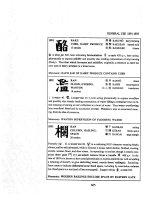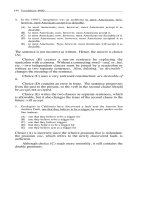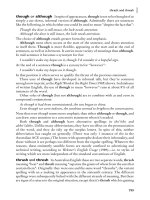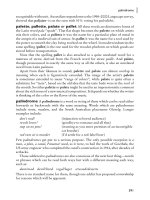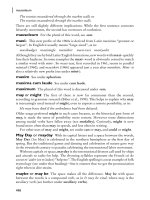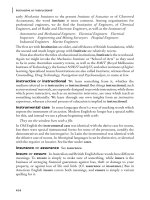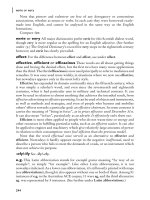the nordstrom way to Customer Service Excellence phần 10 pot
Bạn đang xem bản rút gọn của tài liệu. Xem và tải ngay bản đầy đủ của tài liệu tại đây (174.66 KB, 36 trang )
Play to Win
235
commissions. Nordstrom empowers and encourages its salespeo-
ple to take ownership of their business and to build it up into a
thriving enterprise. To help those salespeople succeed, the com-
pany gives them the necessary tools—inviting stores, lots of
merchandise, thank-you notes, state of the art inventory and re-
plenishment systems, computerized personal books, and so on—
and expects them to use those tools to create their own business.
And as we have seen, the company honors and publicizes and
rewards its top sales performers through designations such as
Corporate Pacesetter All-Star. These people lead by example.
They are efficient with their time; they cultivate long-term re-
lationships with customers; they take initiative; they demonstrate
their product knowledge; and they set and achieve their goals
through outstanding selling skills.
Mentoring, a key aspect of the Nordstrom Way is built on
the pillars of teamwork and unselfishness. Top salespeople are
encouraged to pass on the information they learned from their
mentors. That is how a customer-service, sales-oriented culture
is perpetuated and sustained.
Take for example, Bob Bullard, a million-dollar salesperson in
the men’s wear department at the Corte Madera store in Califor-
nia. A coworker, Kathy Weibel, wrote the following story about
Bullard in the Nordstrom employee publication, The Loop:
Bob is a true team player who gives A+ customer service to his
clients, his coworkers’ customers, and all of us who work in
the store. He is always smiling, knows his merchandise, and
helps educate us and our customers, too. He jumps right in and
cheerfully helps when someone from our team looks “con-
fused” about an upcoming appointment. Bob never assumes
that he should receive part of the commission for helping—and
he does so much. . . .
WHAT EMPLOYEES CAN DO
236
Recently a couple called on a Saturday afternoon. The wife
needed an outfit for a wedding that they were going to attend.
I called to get her information, and she asked if we could also
help fit her husband for a suit. She mentioned that he had re-
cently become partially disabled and was in a wheelchair.
When the couple arrived, all of the sizes I had pulled for
the husband were wrong because his disabilities were more
extensive than I had understood. Not certain how to handle
the situation, I called Bob and he immediately came up with
someone from the tailor shop. He knew how to fit the cus-
tomer’s very narrow shoulders while still making the trousers
work. Bob spoke with the gentleman and understood his chal-
lenges. He made him comfortable and sold him two suits with
all the accessories. The wife bought her outfit from me, and
the two of us had $5,600 in sales.
But the best part was Bob’s dedication to making sure
everything was right for the couple. The wife had tears of joy
in her eyes when they left.
This is a perfect example of the company’s striving to strike
a balance of customer service, teamwork, and individual achieve-
ment. The two Nordstrom employees gave the husband and wife
a positive customer service experience, they worked well to-
gether and they made a sale: win, win, win.
As mentioned earlier, in the Nordstrom culture, this story is
called a heroic andtheyplayacriticalroleintheculture.
Employees who witness a colleague giving customer service
above and beyond the call of duty are encouraged to write up a
description of what they saw or experienced and submit it
to their managers, who will publicly praise that employee. The
best heroic stories are printed in the Nordstrom employee
publication.
Play to Win
237
What Does Teamwork Look Like?.
Teamwork takes many forms at Nordstrom. Sometimes it’s sub-
tle, other times it’s obvious.
A customer wrote a letter to the company to commend the
special service she had received on a visit to the Nordstrom store
at the Mall of America. It wasn’t just any day; it was her wed-
ding day. The customer had forgotten to pack a few items, her
maid of honor needed to buy a dress. The two women had
rushed to take the hotel shuttle to the mall and had about an
hour before they would have to return, in order to get to the
church on time.
The harried customer and maid of honor were greeted by
Catherine Behrendt, a salesperson in the Mall of America store,
who was apprised of the situation and the time constraints in-
volved. Catherine, wrote the customer in a letter to Nordstrom
management, “became part of our team and assisted us in find-
ing a gorgeous dress.” She then escorted the two women to the
shoe department, where she handed them off to salesperson
Joseph Devine.
Meanwhile, Behrendt brought over earrings to complement
the dress as they decided on the right shoes. They purchased two
pairs. “As if this were not enough,” concluded the letter,
“Catherine enlisted the assistance of your store concierge to f ind
the name and location of a mall merchant from whom we could
buy silk flowers.”
That is teamwork.
Of course, the two salespeople in the previous story earned
commission money on those sales. But sometimes the most im-
pressive examples of teamwork occur when salespeople don’t earn
a commission, when those salespeople selflessly go out of their
WHAT EMPLOYEES CAN DO
238
way for the greater good of their department or their store or their
region or their company—or just because it makes them feel good.
Take the example of David Simmons, who sells women’s shoes
in the Florida Mall store in Orlando. Before moving to Orlando,
David worked at the Montgomery (Maryland) Mall. One of his
old customers from that store had been searching for a pair of the
popular UGG boots, but without any success; the boots were vir-
tually impossible to find. The customer decided to contact David
to see if he could locate a pair for her because, she wrote in a let-
ter to Nordstrom, she knew that, “If they existed at a Nordstrom
store anywhere, David would find them! He is the most ambi-
tious, eager-to-please and pleasant salesperson I have ever had.”
Simmons advised the customer that it would be next to im-
possible to f ind the boots, but he told her, he “welcomed the
challenge.” For about a week, he checked the computer daily and
called various stores in California, where he had gotten a lead
that they were getting some in. He kept the customer updated
throughout the entire process. Within days, the pair of UGG
boots she was after was on its way from California.
“Not only that, he suggested I call the store and give them my
information and have them shipped directly to me, even though
he would not get any commission,” wrote the customer. “I think
he was as excited as I was to find the boots!”
Of course, demonstrating that kind of service to the public is
easier to do when you’re dealing directly with the customer.
What about your employees who almost never see or come in
contact with a customer? These people often don’t see the con-
nection between what they do and how they impact the cus-
tomer experience. Nordstrom is creative in finding ways to honor
and single out people in support positions.
An example of how nonsales personnel can show their com-
mitment to customer service is the “White Glove Contest,” a
Play to Win
239
Nordstrom tradition for decades, which gives cash rewards and
honors to Housekeeping/Maintenance departments that keep
their stores clean and inviting to the customers. As Nordstrom
management points out in the newsletter to employees, “A store
can’t win this award unless everyone is involved.”
Team Accomplishments.
It is essential to reward team accomplishments.
Each year, the company gives the President’s Cup to the
stores that have achieved the biggest increase in comparable store
sales over the past year. The contest highlights three winners
every year, depending on the sales volume of the store. As an
added bonus, one of the three Nordstrom brothers—Blake, Peter,
or Erik—makes an appearance in the winning store, and presents
the store employees with a cash prize.
In addition, over the course of the year, individual depart-
ments, stores, and regions are recognized for outstanding sales
and customer service. Again, these awards help to foster the im-
portance of the team—while being fueled by the performance
and success of individuals.
“Selling is a team effort,” said salesperson Leslie Umagat.
“Our success hinges on the support of other salespeople and man-
agement and support staff. You have to be grateful on a consis-
tent basis for your entire team.”
Teamwork Breeds a Sense of Ownership.
Creating a sense of ownership among employees is key to teamwork.
When Rita Noguchi became manager of a women’s apparel
department at the Arden Fair store in Sacramento, California,
there had been a lot of turnover in the department. “So my
WHAT EMPLOYEES CAN DO
240
number one goal was to make sure we had stability,” she said.
“Once you have stability and happy people, you can create on-
going customer relationships, and that’s how your business
grows.”
To instill a sense of ownership in her team, Rita decided to
divide the responsibility in the department. She assigned each
person an area of accountability, such as customer service, new
accounts, and developing personal trade.
One salesperson took the responsibility for new accounts. She
made a chart to monitor each employee’s progress, encouraged
her teammates, and awarded prizes to those who signed up the
most new accounts. The team rose to number one in new ac-
counts for the Arden Fair store, even though they are one of the
store’s smallest departments.
Taking this approach, “made the department more fun, be-
cause each person knew she could make an impact,” said Rita
Noguchi. “We continually challenge each other every day to
be better.”
The teamwork boosted the department’s spirit and, as a re-
sult, the department soon racked up the number one sales-per-
hour increase in the company.
At Nordstrom, when it comes to building positive team re-
lationships, employees are expected to know, understand, and
support team goals, and to cooperate with—and show respect
for—their coworkers throughout the company.
Nordstrom constantly reinforces the idea that when the
company is at its best, it is the result of a group effort. Nord-
strom is both a collection of individuals and a seamless
team, with each member of that team expected to be ready,
willing, and able to take care of each other, while taking care
of the customer.
Play to Win
241
Teamwork cannot be achieved without ethical behavior. Ear-
lier in this chapter, we noted an abuse of the system by a hand-
ful of unethical employees who tried to win a sales contest. And
we saw how Nordstrom dealt swiftly with those employees. In
its training, Nordstrom constantly reinforces the importance of
ethical behavior, and spells out what the company demands from
its employees, specifically honesty, integrity, and consistency in
all their actions.
A recent example of this kind of ethical, unselfish team-
ori
ented behavior happened in a women’s apparel department at
the Nordstrom store in Bellevue Square, across Lake Washington
from downtown Seattle. Salesperson 1 had sold a customer six
sweaters, all in the same style, in different colors. The customer,
who was about to go away on vacation, tried on the sweaters and
found they were the wrong size. Because she was leaving the fol-
lowing day, she took the sweaters back to Bellevue Square to ex-
change them for the right size. Salesperson 1 was off that day, so
the customer told her story to Salesperson 2, who found that the
store was out of the customer’s size. Salesperson 2 called several
Nordstrom stores in the area and found that the sweaters were in
the downtown Seattle store. She personally drove to Seattle—a
20- to 30-minute drive with moderate traffic—to pick up the
sweaters and brought them back to Bellevue Square.
Who received the commission on the sale of those sweaters?
Salesperson 1, who made the original sale.
Who was a great team player?
Salesperson 2, who did not try to record the sale for herself,
but made sure that the sale went to Salesperson 1. And you know
that the next time Salesperson 1 has an opportunity to recipro-
cate, she will, because that’s the way teamwork should be done
the Nordstrom Way.
WHAT EMPLOYEES CAN DO
242
Teamwork across Departments, Business
Units, and Geography.
Nordstrom believes that teamwork brings individuals closer to-
gether and helps different departments gain a better understand-
ing of each other’s role within the company.
So many organizations face the challenge of creating—and
sustaining—relationships with other departments. Without a re-
lationship, it is difficult to understand how the success of that
department has an impact on the success of your department.
In this era of multi-channel service—where organizations can
do business with their customers either through their brick-and-
mortar operations, web site, mail, or telephone—companies are
learning how best to coordinate these individual business units.
At Nordstrom, Nordstrom Direct, a division that has one di-
rect fulfillment center, in Cedar Rapids, Iowa, handles customer
orders from the company’s mail-order catalogs and from its web
site. The Nordstrom Direct distribution facility is set up differ-
ently than those of the full-line stores (the large Nordstrom
stores, as opposed to the smaller Nordstrom Rack discount
stores), because each business unit has its own considerations and
requirements. But they also, at times, must work together.
“In Direct, our fulfillment center is all automated and picks
and packs the items, whereas the full-line (stores fulfillment) cen-
ter is more of a manual process,” explained Ann Delestine, ana-
lyst for the Nordstrom Direct Contact Center. Beginning in
holiday 2002, Nordstrom Direct partnered closely with full-line
stores, “so we understand each other’s systems. I would say the
best thing about this relationship is that neither party looks at it
as ‘Well, it’s your customer or it’s my customer.’ It’s always our
customers. ”
Play to Win
243
Nordstrom urges departments within stores to work with
each other for the greater good.
“I really encourage my crew to create relationships with dif-
ferent departments,” said Angelica Del Bosque, cosmetics man-
ager at Horton Plaza in San Diego. “Think of all the different
customers they have access to that we don’t and vice versa.
We try to include as many departments in our promotions as pos-
sible. During [the Half-Yearly sales], for example, we partnered
with Savvy to promote Juicy Tube lip glosses and Juicy Couture
jumpsuits. We filled up a huge vase with Juicy Tube lip glosses
and put it in their department, and set up a station to let Savvy
customers sample our products while they tried on the jump-
suits.” Since the cosmetics department doesn’t participate in the
Half-Yearly sale, Angelica believed her business would have been
flat without the promotions, but with a little creative teamwork
her team recorded a solid increase.
If a Nordstrom salesperson can’t find a particular item in her
store that a customer is looking for, she will do a “merchandise
check” to find the item at another Nordstrom store, whether it’s
down the road or across the country.
Carolyn Cohn, who sells the exclusively Nordstrom line of
Faconnable women’s apparel at the Fashion Valley, San Diego
store, developed a long-distance teamwork relationship with
Debbie Erbes, a salesperson in another department in the Nord-
strom store in Fashion Square, Scottsdale, Arizona. Explained
Erbes, “I know Carolyn will bend over backwards for me, and I
am reciprocal with her.”
For the first few years of their long-distance teamwork,
Debbie and Carolyn only knew each other through telephone
conversations. Eventually, they had an opportunity to meet in
San Diego and subsequently nurtured a close friendship.
WHAT EMPLOYEES CAN DO
244
“I’d like to develop this kind of relationship with everybody
I speak with,” said Erbes. “A lot of times when a salesperson
from another store calls, I’ll say, ‘How can I make your day?’
They love it.”
When one employee conveys that kind of positive feeling of
cooperation and teamwork, your organization will be well on its
way to giving customer service the Nordstrom Way.
Implementation Lessons from Other Companies.
When Gordon Bethune took over Continental Airlines (the
then-ailing airline) in 1994, he found a company where a series
of previous managements had poisoned the idea of teamwork by
playing off employees against each other. He told employees,
“The only way we all win is if we take care of all the baggage and
all the seating and take off and land on time. That takes team-
work. The gate agents and the flight attendants work together
because they only win when the customers wins, which means
getting the passengers to their destination on time,” Customers
measure success very simply: “Did I arrive safely and on time
and with my underwear?”
Continental’s employees “win” when they place among the
top three airlines in on-time arrivals. “ ‘On-time’ drives every-
thing,” said Bethune. So, they not only have to make sure
the planes arrive at their destination on time, they also have to
have a performance record that is as good or better than the
competition. Competition in the relatively small airline indus-
try is easy to measure because every month, the government
publishes the standings—first place through last place—based
on on-time performance, number of bags lost, customer com-
plaints, and so on.
Play to Win
245
St. Charles Medical Center in Bend, Oregon, has a program
called “people-centered” teams that is about relationship train-
ing. It’s all about “the relationship that we establish with patients,
with families, between each other, ultimately determines the
clinical outcome of patients,” said CEO emeritus Jim Lussier.
He often uses this example: “If you’re going into our surgery to
have your head cut open and have a craniotomy done, would you
rather have it done by a team that is fully functioning, that gets
along well, that supports each other, and is there for the patient,
or one that is constantly, arguing, bickering, having outside af-
fairs. Which do you think will be better clinically?”
Creating that kind of environment is done in a variety of
ways. As an example, Lussier cited a staff member, who admin-
isters EKG tests. That person and a colleague were trying to do
an EKG on a chronically ill child who had been coping with heart
defects since her birth.
“They were having a devil of a time getting a good EKG
done,” Lussier recalled. Nothing was working. “Finally, they sat
down with her and sang ‘Twinkle, Twinkle Little Star’ for a cou-
ple of minutes. It worked. They calmed her down, made her feel
comfortable, and were able to perform the process. When they
were finished, she was happy as a lark. She wasn’t forced into a
situation that would make her uncomfortable.” That’s teamwork.
Lussier is an evangelist for customer service in the health care
industry, where, “patients as customers is totally foreign,” he said.
“Would you go into Nordstrom if the first thing they did was
stick you in a waiting room and say, ‘I’ll be back in an hour’?”
At FirstMerit, it’s the responsibility of every team member to
create a relationship with the customer. All employees involved in
selling bank products are assembled as teams and are taught each
other’s business, including a broad and detailed understanding of
WHAT EMPLOYEES CAN DO
246
the features and benefits of each product and service that a cor-
porate customer would need. They are taught how to identify that
need and how to speak to the benefits of that product.
This building up of relationships among and between these
employees creates camaraderie and a greater desire to help the
group. They know when to smoothly and politely hand off the
customer to the FirstMerit service provider who is trained to ex-
plain the product in greater detail.
“It’s important to build that proper protocol of referral,” said
FirstMerit CEO John Cochran. “It’s equally important for the
banker who receives the referral to acknowledge the employee
who made it happen. It’s just like when someone walks into the
clothing department at Nordstrom and buys a suit. The sales-
person who sold the customer that suit then takes the customer
into another department to sell him shirts and ties and socks. The
responsibility of the person who open that line of credit or check-
ing account, and so on is to introduce the customer to the addi-
tional services.”
For example, a customer told a FirstMerit customer-service
representative that he had just been awarded a large monetary
claim from an insurance company for a personal injury. The
FirstMerit customer-service representative immediately referred
the customer to FirstMerit’s trust department, where an expert
spoke to the customer about the necessity for estate planning.
For all employees—from tellers to branch managers—who
come in direct contact with customers, a portion of their com-
pensation is tied directly to their ability to successfully help sell
the customer a product that they don’t personally sell themselves.
“We thrive on internal competition,” said Cochran.
Cochran said the FirstMerit’s best personal bankers are the
ones who have the best teamwork inside their branches. “They
Play to Win
247
don’t see the goal as ‘my’ goal, but rather ‘our’ goal. They look
for how to help each other achieve their goals. We constantly
drive home the point that the customer’s experience in the
branch is fully owned by the branch and by every employee who
works in the branch. That’s teamwork.”
FirstMerit develops a healthy sense of camaraderie, by offer-
ing a variety of categories, including “most improved,” where
many employees can get a chance to win something. The con-
tests run for specific periods of time, usually six to eight weeks,
so they create bursts of energy and focus that generate revenue
and build customer relationships that can last all year. Because
these contests run for short periods of time, employees know they
need to maximize their efforts because they don’t know when
the next one is going to come.
Individuals have to operate as a team. FirstMerit, which was
inspired by Nordstrom’s penchant for contests, launched a con-
test of its own, called “The Best Branch,” which include a vari-
ety of criteria, including achieving sales quotas, service quality,
community involvement, and reports from mystery shoppers. All
the categories and criteria are geared toward enhancing the cus-
tomer experience while meeting performance expectations and
revenue goals. Since everyone has a scorecard, all employees
know exactly where they stand, and what they need to do in
order to create a unique FirstMerit experience. These are team
goals for each bank branch, not the goals of individuals.
As Cochran sees, it, “At Nordstrom, the guy who’s selling
shoes needs the guy selling suits to refer him business. At the end
of the day, you’re going to figure out that, in order to get good at
your job, you need to be cooperative with a fellow team member.”
The first edition of this book ended with a quote from John
N. Nordstrom of the third generation of Nordstroms, who was
WHAT EMPLOYEES CAN DO
248
interviewed for a corporate video for new employees. This state-
ment by the retired co-chairman, this grandson of founder John
W. Nordstrom, remains just as relevant today:
Our commitment is 100 percent to customer service. We are
not committed to financial markets; we are not committed to
real estate markets; we are not committed to a certain amount
of profit. We are only committed to customer service. If we
make a profit, that’s great. But customer service is first. If
I’m a salesperson on the f loor and I know that the people that
own this place are committed to customer service, then I am
free to find new ways to give great customer service. I know
that I won’t be criticized for taking care of a customer. I will
only be criticized if I don’t take care of a customer.
Keys to Success
Ⅲ Find ways to balance individual achievement and teamwork.
Ⅲ Honor team achievements.
Ⅲ Show how every team member is important to customer ser-
vice—even if that team member has no direct contact with
the customer.
Ⅲ Promote teamwork among groups within your organization
and find ways for them to compete—on a positive basis—
with other teams within your organization.
Ⅲ At the same time, promote the larger team—your entire or-
ganization—in its competition with your rivals.
(Continued)
Play to Win
249
(Continued)
Ⅲ Encourage people to take ownership of customer-service issues.
Ⅲ Promote ethical behavior.
Ⅲ Promote unselfish behavior.
Ⅲ Promote teamwork across all departments, business units,
and regional offices.
Ⅲ Encourage employees to cite the teamwork example of
other employees.
Ⅲ Publicize those “heroic” stories of teamwork throughout
your organization.
Ⅲ Make them part of your value system.
EXERCISE
Team Achievement
Do you honor team achievement within your organization? How
can you make team achievement a bedrock of your culture?
Ⅲ Assemble a group of people from all departments within
your organization. Their assignment is the following:
Ⅲ Create categories for team achievement.
Ⅲ Devise awards for honoring team achievement.
Ⅲ Determine the criteria for winning each award.
Ⅲ Determine how each award will be judged.
WHAT EMPLOYEES CAN DO
250
EXERCISE
Ethical Behavior
Ⅲ Assemble a group of people from all departments within
your organization. Their assignment is the following:
Ⅲ Create your own list of ethical behavior guidelines.
Ⅲ Distribute that list to all members of your organization.
Ⅲ Ensure that those guidelines become an essential part of
your culture.
EXERCISE
Teamwork Requirements
Nordstrom has a list of requirements to promote team goals.
Ⅲ Assemble a group of people from all departments within
your organization. Their assignment is the following:
Ⅲ Create your own list of requirements for team goals.
Ⅲ Distribute those requirements to all members of your
organization.
Ⅲ Ensure that those requirements become an essential part of
your culture.
Play to Win
251
EXERCISE
Ownership
How can people who don’t deal with a customer, feel a sense of
ownership of the customer service experience?
Ⅲ Assemble people in your organization. This group should be
comprised of frontline and support staff.
Ⅲ Brainstorm how support staff can be made to feel a part of
the customer service team.
Ⅲ Design a way for support staff to meet and discuss customer-
service issues with your customers.
Ⅲ Discuss ways that different departments, business units,
and regional offices can interact to best serve the needs of
your customers.
Ⅲ Record all those ideas and distribute it to all members of the
organization.
Ⅲ Ask for additional suggestions.
EXERCISE
Heroics
As we have seen, heroics—examples of outstanding teamwork—
are a part of the Nordstrom culture.
Ⅲ Devise ways of encouraging all members of your organiza-
tion to single out their coworkers for “heroic” stories.
Ⅲ Find ways to spread these stories throughout your organization.
253
Appendix
Nordstrom Heroics
Inspirational Tales of Teamwork and
Legendary Customer Service
W
hen a Nordstrom employee witnesses a coworker pro-
viding great customer service—whether for a cus-
tomer or a colleague, he or she is encouraged to write up what
that coworker has done, and these write-ups are shared with
other employees. In the Nordstrom culture, these stories are
called heroics. Heroics are an essential feature of the Nordstrom
Way because they demonstrate and illustrate qualities of team-
work and customer service that ultimately produce sales. They
also allow employees to recognize fellow employees for the spe-
cial lengths they go through for a customer (who may never
know what that “heroic” employee did).
By sharing these heroics, Nordstrom management honors and
salutes employees who go above and beyond the call of duty,
which sends the message that customer service—both internally
and externally—is what makes Nordstrom Nordstrom.
The examples of Heroics in this Appendix originally appeared
in the Nordstrom employee publication, The Loop. ( For pri-
vacy, names have been omitted.)
APPENDIX
254
Trusting the Customer.
An employee from the Easton Town Center store wrote this note
praising one of her coworkers:
Recently, a couple from New Hampshire stopped in Studio
121 and this employee helped them. The wife tried on a red
jacket with matching sweater and looked fabulous. Her hus-
band kept telling her to buy them, but she hesitated even
though she loved them.
The salesperson questioned the customer about her hesitation.
The customer told her they were in from out of town for a
party, and she hadn’t brought her jewelry. The salesperson
asked the customer if she liked the necklace and earrings the
salesperson was wearing, and the customer replied yes. The
salesperson offered to loan them for the evening. The customer
bought the jacket and sweater and when the salesperson
wrapped the purchases she also wrapped her jewelry to go with
them. The couple was staying close to where the salesperson’s
son works, so she gave them directions to drop off her jewelry
with him. The jewelry was returned along with a very gra-
cious thank you note.
Helping a Cancer Survivor Feel Better about Herself.
A manager at a Nordstrom store in Oakbrook, Illinois, wrote up
this heroic describing the compassion of a salesperson in her store:
A customer from Wisconsin has never been to our store and
has never seen her salesperson’s face. Her Nordstrom cosmetics
salesperson helps her entirely by phone. From the begin
ning,
the salesperson did all the right things. She suggested great
products, included free samples, went to different cosmetic
lines to find products and shipped everything to Wisconsin.
Appendix
255
The salesperson has been following through to take care of
the customer’s needs for about a year.
Sadly, the customer has cancer. A year ago she received
her diagnosis and deals every day with the effects of the dis-
ease. She has had trouble feeling pretty, has lost her short-
term memory and sense of smell, and worries about her
husband.
The customer says the service she receives makes a world
of difference. She feels beautiful again, and says that her Nord-
strom salesperson has been part of her recovery process.
Helping a Customer Through Brain Surgery.
An employee at a Nordstrom store in the Washington DC area
wrote this Heroic about his coworker:
I’m not sure how the call originated, but this employee
helped get an outfit to a man who was having brain surgery
at Fairfax hospital. He was traveling from Portland, Maine,
and had to have emergency surgery while here in Virginia.
She brought him some clothes and learned that his wife had
nothing to wear that worked with our climate. She had bor-
rowed clothes from the nurses. So, the salesperson offered to
pick her up at the hospital and bring her here to the store to
do some shopping. The woman was delighted and found
some outfits. The employee returned her to the hospital after
her shopping spree.
Stepping in for a Coworker.
The manager of a department in a Nordstrom store in Portland,
Oregon, wrote this heroic about a salesperson’s team spirit, drive,
and willingness to serve:
APPENDIX
256
I was apprehensive about leaving my crew for a vacation be-
cause of the heavy shipments of anniversary merchandise we
were receiving.
This salesperson must have known I was nervous about
being gone. He offered to swap shifts with a coworker over the
weekend so he would be opening. This would allow him more
time to work the merchandise, set the f loor, and pull figures.
I was impressed with his confidence as he read my ex-
pectations and said, “No problem!” And before I left, he
showed initiative by calling me with a suggestion for orga-
nizing the stockroom. His ideas saved everyone else a lot of
time and energy!
When I returned, the stockroom looked great; there was
a pile of figures on my desk for my review, and the jeans were
all sized and folded on the back wall. He showed great leader-
ship in stepping up to get things done, and also effectively del-
egated projects to other crew members. I feel fortunate to have
such an amazing person on our f loor.
How Support People Provide Customer Service.
Organizations often ask how they can get their back-office or
support people—employees who rarely, if ever, deal with the
customer—to understand the connection between their jobs and
taking care of the customer. Here are some examples of how non-
salespeople at Nordstrom seized the opportunities to provide
great customer service.
The store administrator at a Nordstrom store in Atlanta,
Georgia, wrote this Heroic recognizing two employees in Loss
Prevention:
These two men are awesome! I know I can always count on
them. Last weekend I was expecting a shipment from FedEx
that did not arrive on time. I told one of them, and he took
the initiative to call FedEx and make arrangements to pick
Appendix
257
the shipment up at the local station, which happened to be
close to where his coworker lived. One of these employees
called the other and asked him to pick up the shipment before
he got in at 7:00
A
.
M
. on Monday. He arrived with just one
box that was smaller than I expected. Apparently, there were
supposed to be three boxes. He returned to the FedEx station
to retrieve the remaining boxes without question.
These guys are just amazing. Thank you, gentlemen, for
taking care of me and the store!
A Nordstrom department manager in the Troy, Michigan,
store sent this Heroic to thank the Region’s Emergency Response
Team for their help during the East Coast Blackout of the sum-
mer of 2004:
On behalf of my team, please thank the entire Central States
Emergency Response Team for their support and assistance
during a challenging time. I will never forget the initial feel-
ing when our power went out. The Somerset Emergency Re-
sponse Team kicked into action—standing at doors to assist
customers and checking dressing rooms, restrooms, and the
elevators for distressed customers. Management secured the
store while at the same time assisting any customer who
wished to continue shopping.
All the members of the our Emergency Response, Loss
Prevention, and Maintenance and Housekeeping teams should
be commended for their patience and hard work during this
hectic crisis.
The promptness and high sense of urgency displayed by
the entire region helped us to have light at the end of our tun-
nel while we were in the dark.
A Customer Service Specialist came to the rescue of a cus-
tomer in need:
APPENDIX
258
She went above and beyond to help a customer who was trav-
eling in France. The customer was out of money, her ATM
card was not working, and she had no place to stay and noth-
ing to eat. Thousands of miles away from home, unable to
reach her family and with no resources, the customer con-
tacted her credit card companies, hoping they would tem-
porarily increase her line of credit. None were willing to help
her, until she contacted Nordstrom.
Without hesitation, the Nordstrom Customer Service Spe-
cialist increased her line of credit so that she would be able to
afford food and lodging until her f light back home. The cus-
tomer said that the Nordstrom employee took care of her like
family and that her actions spoke for Nordstrom’s uniqueness.
Teamwork, Teamwork, Teamwork.
A department manager at a Nordstrom store in New Jersey sent
in this heroic recognizing the talents of several employees in the
Tailor Shop and Alterations department:
I had a customer who was leaving for Milan the next day. He
only wanted a pair of Norsport pants to wear between busi-
ness meetings. He mentioned that he needed other things, but
was going to buy them there because he didn’t think it would
be possible to get the alterations done in time.
I showed him a lot of things that he might like for his
trip—why waste time shopping for clothes on your vacation?
We tried to find pants with exact length sizes, but to no
avail. I called a tailor from the Tailor Shop. He graciously
agreed to have them done in an hour.
Then the customer needed a jacket. I showed him the
washable suede from Newport Harbor. Both he and his wife
loved it, but the sleeves had to be shortened. The Tailor Shop
was overwhelmed, so I asked Alterations for help. One em-
ployee offered to have it done first thing in the morning. The
Appendix
259
customer was happy to pick it up on the way to the airport.
The employee in Alterations asked if someone from the Tai-
lor Shop could just measure the sleeves. One of the tailors came
down to measure them agreed to be a hero and do the sleeves
before the customer came back for his pants, rather than hav-
ing Alterations take care of it in the morning.
Three of the customer’s shirts also had to be pressed for the
trip. I thought I had done enough to bother the guys in the
Tailor Shop for the rest of the year, so I proceeded to press
them myself. One of the tailors was just finishing pressing
some other items, so I asked him to show me how to work the
big steamer. He proceeded to do the shirts for me, and
wouldn’t stop even when I asked him to.
I let the employee in Alterations know that I appreciated
her help, but that the Tailor Shop came through and every-
thing was ready for the customer when he returned. He was
so pleased, and what was originally a $39.50 sale turned into
a $650 sale! Please recognize everyone—they each deserve a
special prize for this Heroic.
A salesperson from the Short Hills Mall store sent this letter to
Nordstrom President Blake Nordstrom, because she wanted to
recognize the lengths her team members went to on her behalf to
make sure they did not disappoint a customer.
I am writing to you to let you know the exemplary ser-
vice experience that I had the pleasure to witness. One crazy
Saturday in October, we had a customer call who was sup-
posed to receive a Roberto Cavalli dress overnight for Sat-
urday delivery. She was wearing it to an event that evening
and the dress never arrived due to DHL’s mistake. The cus-
tomer was upset as she had purchased shoes and accessories
to go with the dress. An employee from the Collectors de-
partment, the store manager, and myself sprang into action
to try to alleviate this issue for the customer. We went to

